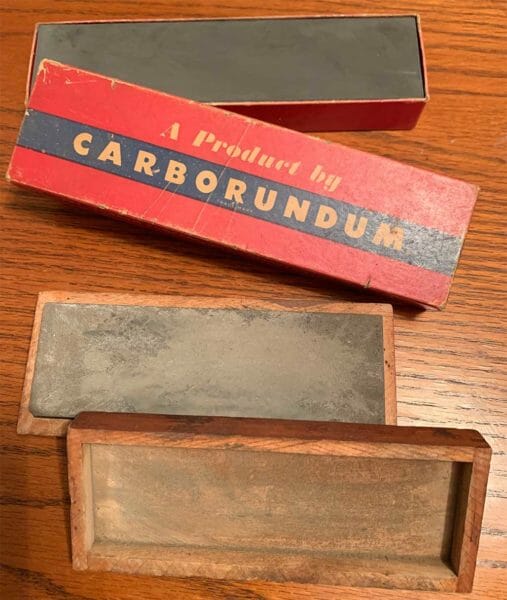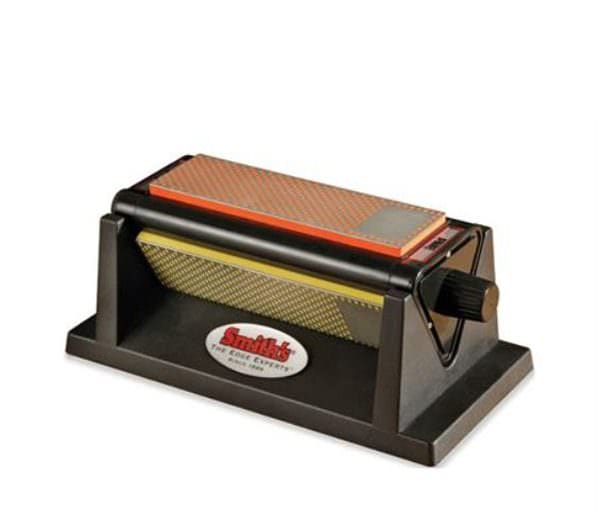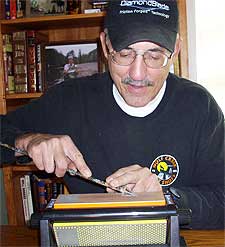
Idaho – -(AmmoLand.com)- I’ve written a million knife-related articles and taught a bunch of Knife Sharpening/Choosing The Proper Knife seminars. In fact, as I type this article, I’m on a plane headed to the 2020 Dallas Safari Club Conv. & Expo to conduct such a seminar. I’ll conduct three at the SHOT and in Feb. a Knife Seminar at SCI in Reno.
But I thought it’d be fun to write an Old School knife sharpening article. I’ve never done that before. I guess what prompted this thought, was my mom had to hit the hospital for an issue Christmas week. I ran down to see her and she told me to go through some of dad’s old stuff and see if I wanted any of it. While digging through his closet I ran across two of his old whetstones.
As a kid, dad was the official camp knife sharpener in our deer camps. Maybe that’s where I got my loves of knives from? In those days the knives were made out of a lot softer metal than nowadays. All that you needed were two stones max, a coarse stone, and an Arkansas stone. I ran across both of these in his closet.
You can see from the pic what they looked like, nothing special and yet they sufficed for him and all of the other old-timers in his day. Things were simpler then. As far as I know, most of the knives had around 30-degree angles as compared to nowadays. Now, other than some cheap Chinese knife they’re all going to be 24, 22, 18, 16 and even some 14-degree edges.
Knife manufacturers can use these angles now because the metal they use is so much harder. In the old days, the metal they used was softer. If they had used our current angles, their edges would have rolled or chipped. So when you see a knife with a 14 or 16-degree angle, you know it’s going to be hard. So you’ll need to use a diamond stone like one of the Smith’s Consumer Products fine diamond stones #add.

But back to the old school days. A few years ago while conducting a Knife seminar at Cabela’s an attendee asked me if I’d ever used a rock to sharpen my knives. He said he was from Guatemala and he remembered his grandad using smooth river rocks to sharpen his ax. I shrugged my shoulders and said yeah, I guess that’d work. I know in Idaho the rocks in our mountain rivers get smooth from the sand and water flowing over them so I could see that working fine.
I wasn’t around in the cowboy/Indian days but I don’t recollect reading that they had a local Cabela’s to buy a Smith’s Consumer Products diamond stone, so I imagine they used a rock, don’t you? A while back when I tested a Wazoo Viking sharpener #add, I found out from them that the old Vikings carried a whetstone on a leather thong around their neck.
Now to skip to the present day without using our modern sharpening tools, here are a few methods I’ve heard about with old age creativity. I’ve seen people use the bottom ring on a ceramic coffee cup. Same thing as a ceramic steel when you think about it. Along those lines, I didn’t realize it until talking to my buddy Joyce Laituri, the marketing guru for Spyderco but she told me that Spyderco actually got their start by making ceramic sharpening tools and expanded to their modern-day presence from there. I’ve been meaning to do an article on Spyderco’s history since she told me that last year at SHOT and haven’t had time.
Then a few years back someone showed me a YouTube of a guy that rolled down the window of his truck halfway down and stropped his knife on the edge of the window. Unique and creative. In a pinch, I’ve used a smooth stainless pipe or rod to steel a knife or to retrieve an edge.
So, as we come to a close, yes, I still recommend buying and using a Smith’s Consumers Products fine diamond stone and one of their Arkansas stones but in a pinch don’t despair and slit your wrist with a dull knife. Get creative and use one of the above alternative methods. Or look around and use something available in your current environment and think outside of the box. Good luck.
About Tom Claycomb
Tom Claycomb has been an avid hunter/fisherman throughout his life as well as an outdoor writer with outdoor columns in the magazine Hunt Alaska, Bass Pro Shops, Bowhunter.net and freelances for numerous magazines and newspapers. “To properly skin your animal, you will need a sharp knife. I have an e-article on Amazon Kindle titled Knife Sharpening #ad for $.99 if you’re having trouble.”


I still have the Carborundum in the pic. I watched my Mom sharpen our knives and learned from her.
I have the same Carborundum as well. But I don’t use it, since I have one of the diamond hone type sharpeners, that is two sided, and fits inside the handle. It works so well, I use it pretty much exclusively. I have found that for me and my inexpensive knives, if I keep them sharp, they do pretty good. If I let them get too dull, they can be harder to get back to where they should be. So the old stitch in time, saves nine, seems to be the rule.
I still have my Spyderco ceramic kit from the late 70’s. Still works like it did when new. It came in a soft leather roll with three, twin rod series of grit. Set into the holder at 30ish degrees, all one has to do is stroke straight down, while holding the edge to the rod. From repairing a grossly worn edge, to a simple hone, my Spyderco kit has never failed.
I’ve used the window edge lots of times. It WORKS. Especially good for sharpening serrated blades.
Have a Spyderco triangle and a Lansky kit. Have pocket sharpener for field maintenance.